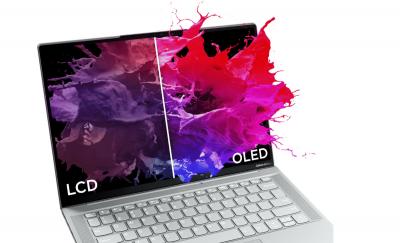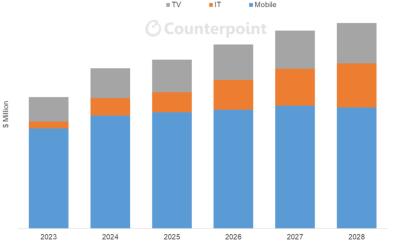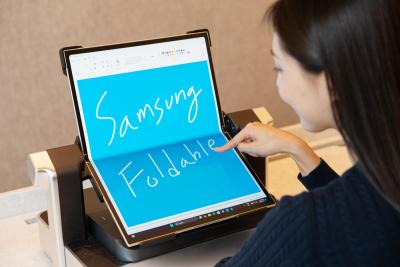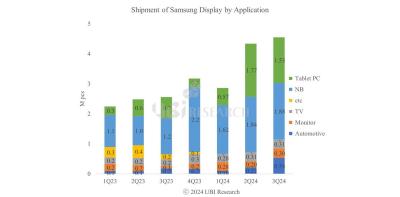OLEDs for laptops - introduction and industry news.
OLED (Organic Light Emitting Diode) is a display technology that is brighter, more efficient, thinner and feature better refresh rates and contrast than an LCD display. OLEDs deliver the best picture quality ever and OLED displays have been used in smartphones, wearables and TVs.

Why are OLED displays better than LCDs?
- In OLED displays, each pixel emits light independently (in LCDs, there is a white backlight).
- The contrast ratio of OLEDs is much better than in LCD, so are the refresh rates and the viewing angles.
- OLEDs are thinner and lighter than LCDs, and can be made flexible, foldable, rollable and transparent.
- OLEDs are more efficient, as only lit pixels draw energy. A smart user interface can result in very power efficient OLED displays!
One of the major drawbacks of an OLED display is that because each pixel is driven independently and because the lifetime of an OLED emitter is limited, OLED panels suffer from image retention (known as burn-in). A much-used pixel is less bright than a pixel that hasn't been driven a lot (for a more technical explanation, click here). In computer user interface this is a problem - as some UI elements are quite fixed (toolbars, icons, etc). There are some technologies to handle this problem - for example by measurement and compensation, by using a tandem architecture to extend lifetime, and more. As there are millions of laptops sold annually with OLED displays, it seems as the industry has pretty much solved the burn-in problem.
OLED laptops today
OLEDs are already very successful in smartphone displays (where almost a billion panels are produced annually), OLED TVs and wearables. For some years now we are seeing an increased adoption of OLED displays in laptops, as companies such as Lenovo, Dell, HP, Samsung, Xiaomi and others adopt high-end AMOLED displays in their high-end and mid-range laptops. Click here for our complete list of laptops with OLED displays.

Further reading
Counterpoint: OLED shipments grew 28% in Q3 2024, driven by higher demand for smartphones, TVs and laptops
Counterpoint (DSCC) says that OLED panel revenues increased 28% in Q3 2024, and the company expects revenues in all of 2024 to grow 16% from 2023, mainly driven by growth in smartphones, TVs and IT applications.
In terms of unit shipments, Q3 2024 saw a 34% increase from Q3 2023. Shipments of OLED smartphone panels increased 43% from 2023 (and 24% in revenues). OLED TV shipments grew 48% in the quarter (36% increase in revenue). The largest increase came from laptop OLED panels that more than doubled (108%) in shipments in Q3.
Samsung Display to start producing rollable OLED laptop displays in April 2025, Lenovo is its first customer
Samsung Display unveiled a 18.1" rollable OLED laptop display at CES 2025, one that can roll down to 13.1" when closed. The company today announced that it aims to begin mass producing rollable OLED displays in April 2025. This will mark the first ever mass produced rollable display (apart for the limited volume production of LG's 65" rollable TV screens, that are discontinued).
During CES, Lenovo demonstrated the first laptop to use such a rollable OLED, the ThinkBook Plus G6 Rollable laptop. Lenovo plans to launch it globally in June 2025. The ThinkBook Plus G6 Rollable will have a 14" 5:4 display when rolled in, and a 16.7" 8:9 display when opened. That's an increase of almost 50% in screen size. The price of Lenovo rollable laptop will start at $3,499 - this is a ultra premium device.
DSCC: the OLED materials market grew 22% in 2024, Chinese material makers enjoy a sharp increase in demand
DSCC (now part of Counterpoint) says that OLED evaporation material sales will grow 22% in 2024, and will continue to grow at a 6.4% CAGR from 2024 to 2028. Most of the growth will come from IT display panels, for laptops, monitors and tablets.
Interestingly, DSCC estimates that Chinese material developers enjoyed a 58% increase in sales in 2024 to $252 million. The primary reasons for this sharp increase in demand is increased utilization at Chinese AMOLED fabs, increased orders from local companies in China over sourcing these materials from the rest of the world, and new range of materials introduced by materials makers (as Chinese material developers move from intermediates production to emitters and dopants).
Samsung Display shows new OLED technologies at CES 2025
Samsung Display is set to show new OLED technologies at CES 2025, including new foldable display, rollable ones, automotive displays, next-gen QD-OLED panels and more.
So first up, Samsung will be showing a 18.1 foldable OLED display (which it says is the world's largest). This panel is suitable for IT devices - to enable devices that combine tablet, laptop and monitor devices into one. When folded, this display is 13.1" in size.
UBI: Samsung's automotive OLED shipments rise, but sales of tablet OLED displays are soft
UBI Research says that Samsung Display's medium and large OLED panel shipments in Q3 2024 were the same as in the previous quarter. Shipments of tablet OLED devices were low, but this was offset by increased sales of automotive displays. Compared to 2023, total medium and large OLED panel shipments more than doubled, mainly due to increased sales of tablet panels to Apple, and increased laptop OLED shipments.
UBI estimates that SDC's tablet PC sales decreased by 38% compared to the previous quarter. Automotive OLED shipments rose from 100,000 units in Q1 2024 to around 500,000 in Q3.
Omdia updates its Apple laptop and tablet adoption forecast, with new devices arriving in 2026 - and Apple's first foldable laptop by 2028
Omdia has updated its Apple iPad and Macbook display roadmaps, with new forecasts and information about Apple's OLED adoption plans in its IT product lines.
According to Omdia, Apple's iPad Mini will get a 8.4-inch LTPS OLED display in 2026. In 2027, Apple will also introduce OLED displays in its iPad Aid models (11-inch and 13-inch). In 2028 Apple will revamp the OLED displays in its iPad Pro models, offering a tandem architecture, polarizer-free OLED design and LTPO backplanes.
Omdia: large-area OLED panel shipments to grow 116.5% in 2024, and 32.7% in 2025
Omdia estimates that shipments of OLEDs over 9-inch in size (which Omdia defines as large-area OLEDs, although most companies will refer to these sizes as medium-sized OLEDs) will increase 116.5% in 2024, and will rise a further 32.7% in 2025.
This growth is driven by increasing demand for OLED monitors, tablets and laptops.
Applied Materials launches a maskless OLED production technology, to support 8-Gen high efficiency OLED deposition and encapsulation
Applied Materials announced a technology, branded as MAX OLED that enables OLED display production on large glass substrates, aiming to provide a cost-effective solution to produce TV and TV displays. Applied developed and patented a new OLED pixel architecture and a "dramatically different manufacturing approach" that the company says enables brighter, clearer, more energy-efficient and longer-lasting.
Applied's new MAX OLED systems can scale from 6-Gen substrates to 8-Gen substrates, supporting the new wave of IT OLED production lines. Applied says that its new solution has strong customer interest - and already achieved repeat orders from several leading display makers (see below). Specifically, Applied announced that it will supply an R&D system to Samsung Display that will test the new production technology for its AMOLED and QD-OLED production technologies.
Samsung Display aims to increase its AMOLED production by 10% in 2025, hoping to sell more tablet displays and foldable displays
According to a report from Korea Samsung Display aims to increase its small-sized and mid-sized AMOLED panels production in 2025 by 10.25% compared to its 2024 production (or 475 million panels up from 432 million panels).
Of course SDC's production plans depend on market demand, but it seems as if the company believes the OLED market is set to grow or that the company aims to grab a larger share of the market. SDC mostly aims to increase production of IT panels (laptops and tablet displays) and foldable smartphone OLED panels.
BOE may face delays in its 8.6-Gen IT flexible OLED line, as one of its suppliers faces financial problems
Towards the end of 2023, BOE officially announced its plans for a 8.6-Gen flexible LTPO AMOLED line in Chengdu. The agreement with Chengdu's local government was signed in early 2024, and in April BOE announced it is starting to construct the new fab. A few weeks ago BOE said it finished the construction of the main outer structure in this project, and that the company is on track to finish the fab by May 2026, with mass production expected by October 2026 - and full production in 2029.
Today there is a report from Korea that one of BOE's suppliers, Hansong Neotech, faces financial problems (and its stock has been delisted from the Korean stock exchange). The company may not have enough money to coninute its operations and build the BOE systems.
Pagination
- Page 1
- Next page













